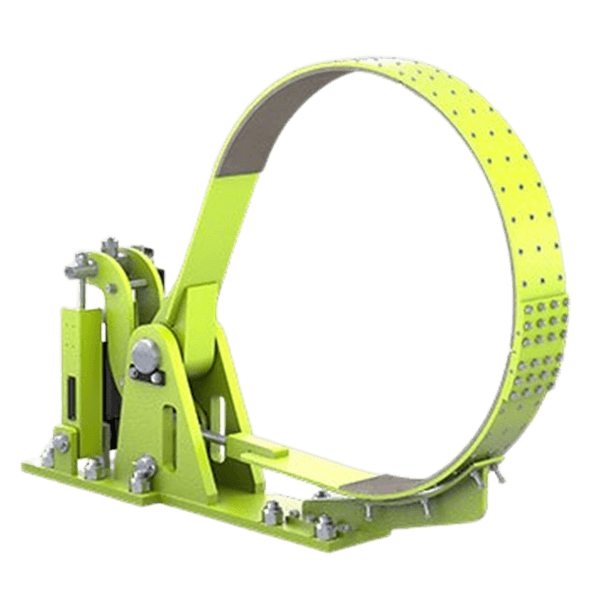Braking systems are crucial in ensuring operational safety, reliability, and efficiency in the industrial world. Among these systems, drum brakes are a popular choice for heavy-duty applications, particularly in environments where space is limited and safety is paramount. Huebner Speed Monitoring specialises in industrial drum brakes, offering cutting-edge solutions designed to prevent uncontrolled operation in machinery like cranes, hoists, and winches.
This article explores the fundamental principles, their industrial applications, and how they differ from “normal brakes” commonly found in automotive or lighter-duty systems.
What Are Drum Brakes?
They are a type of braking system that uses friction created by brake shoes pressing against the inside surface of a rotating drum. The system connects the drum to the machinery’s moving part, such as a crane or winch. The brake shoes generate friction to slow down or stop the movement..
In industrial settings, drum brakes are engineered to handle high loads, operate reliably under extreme conditions, and ensure precision stopping, even in tight spaces.
How Do Drum Brakes Work?
The working principle of these brakes in industrial applications involves the following key components:
- Brake Drum: The cylindrical component that rotates with the machinery. It serves as the contact surface for the brake shoes.
- Brake Shoes: Semi-circular components lined with friction material that press against the drum to create braking force.
- Actuator: The mechanism (hydraulic, pneumatic, or electric) that applies force to the brake shoes.
- Return Springs: These ensure the brake shoes retract when the braking force is released.
- Friction Material: High-durability materials designed to withstand extreme loads and high temperatures.
When the actuator applies force, the brake shoes press against the drum, converting the machinery’s kinetic energy into heat, which is then dissipated.
Industrial Applications of Drum Brakes
They are widely used in industrial applications where safety, reliability, and precision are non-negotiable. Common use cases include:
- Cranes: They are essential in cranes to control lifting and lowering operations, especially in environments like construction sites, ports, and industrial facilities.
- Hoists: In hoisting applications, They provide the stopping power needed to handle heavy loads, ensuring smooth and safe operation.
- Winches: Winches, used for pulling or lifting loads, rely on them to prevent uncontrolled movement during operation or load handling.
- Mining and Heavy Equipment: They are often used in mining equipment and other heavy machinery where reliability under harsh conditions is critical.
How Drum Brakes Differ From Normal Brakes
While drum brakes’ basic principles are similar across industries, they differ significantly in design, performance, and application from the “normal brakes” found in vehicles or lighter-duty systems.
Design and Size
Industrial drum brakes are designed to handle higher loads and operate in extreme conditions. They are larger and more robust than normal brakes.
Durability and Materials
Industrial drum brakes are built with heavy-duty materials such as cast iron or steel to withstand high loads, extreme temperatures, and prolonged use.
Operation
They often rely on advanced actuators (hydraulic, pneumatic, or electric) and are integrated with monitoring systems for precision control.
Applications
Industrial drum brakes are used in machinery where safety is paramount, such as cranes, hoists, and mining equipment.
Why Choose Huebner Speed Monitoring for Drum Brakes?
Huebner Speed Monitoring offers industrial drum brakes designed to meet the highest safety and performance standards. Key features of our solutions include:
- Compact Design: Perfect for applications in limited spaces.
- High Reliability: Prevent uncontrolled operation in critical machinery.
- Tailored Solutions: Designed to meet the specific requirements of cranes, hoists, winches, and more.
FAQs About Drum Brakes
What makes drum brakes suitable for industrial applications?
They are designed for heavy-duty use and offer superior durability, reliability, and precision in demanding environments.
How are industrial drum brakes maintained?
Regular maintenance involves inspecting the brake drum, shoes, and actuators for wear, ensuring the friction material is intact, and checking for proper alignment and lubrication.
Can drum brakes handle high loads?
Yes, they are specifically engineered to handle high loads and maintain consistent performance in heavy-duty applications.
Are drum brakes better than disc brakes for industrial use?
Drum brakes are often preferred in industrial settings because they generate higher braking force, durability under extreme conditions, and compact design.
How often should industrial drum brakes be inspected?
The frequency of inspection depends on the application and usage. For critical machinery, it’s recommended that drum brakes be inspected every three to six months or as specified by the manufacturer.
Why choose Huebner Speed Monitoring for industrial drum brakes?
Drum brakes are indispensable in industrial machinery, offering unmatched reliability and safety in applications like cranes, hoists, and winches. By understanding how they work and how they differ from normal brakes, operators and businesses can make informed decisions about their braking systems.
Huebner Speed Monitoring provides expertly designed industrial drum brakes tailored to meet the rigorous demands of heavy-duty applications. Contact us today to explore how our solutions can enhance the safety and efficiency of your operations.

